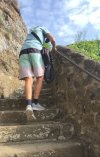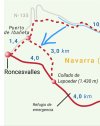I don't think it is clear he has a bodily impairment and don't know why you would assume that. Suggesting he reconsider undertaking a lot of walking isn't really all that different from suggesting he reconsider walking any future Caminos.
I had terrible knee issues on my 2016
Camino Frances from Roncesvalles. I needed knee braces, lots of ibuprofen, and hiking poles to continue my Camino and, to the end, if I tried to stop with the ibuprofen or knee brace, I found that I couldn't make it and needed to resume them. I don't think that is far off from taking an occasional rest day for my knees. (I also took a couple of rest days in the course of my Camino after the knee problems emerged.)
I don't think I have a bodily impairment. If I did, I wouldn't have been able to walk the San Salvador and Primitivo last summer without any knee brace or ibuprofen or pain. Two routes much more challenging to the knees than the Frances. I just needed to let my knees heal and support them better on future long walks. Which is apparently what Billy is doing.
While my doctors have never proactively recommended a Camino, they have suggested it is a good thing, as long as I pay attention and listen to my body. They haven't responded that it would wear my body out like a professional athlete's body leading to early retirement.

























